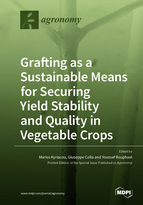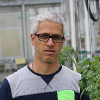Grafting as a Sustainable Means for Securing Yield Stability and Quality in Vegetable Crops
A special issue of Agronomy (ISSN 2073-4395). This special issue belongs to the section "Horticultural and Floricultural Crops".
Deadline for manuscript submissions: closed (15 August 2020) | Viewed by 65363
Special Issue Editors
Interests: horticulture; vegetable science; grafting; microgreens; fruit and vegetable quality; ripening physiology; postharvest physiology; carbohydrate metabolism; phytochemicals; functional compounds
Special Issues, Collections and Topics in MDPI journals
Interests: microgreens; sprouts; functional food; crop production; plant nutrition; fertilizers; organic farming; organic agriculture; nutrient management; biofertilizers; vegetable production; fruit quality; fertigation; hydroponics; vegetable crops; biofortification
Special Issues, Collections and Topics in MDPI journals
Interests: greenhouse crops; vegetables production; hydroponics and aquaponics; plant nutrition; microgreens; sprouts; edible flowers; functional foods; grafting; microbial and non-microbial biostimulants; biofortification; vegetable quality related to preharvest factors; LED; urban agriculture; organic farming
Special Issues, Collections and Topics in MDPI journals
Special Issue Information
Dear colleagues,
Vegetable growers around the world only collect on average half of the yield they would obtain under optimal conditions, known as yield potential. It is estimated that 60-70% of the yield gap is attributable to abiotic factors such as salinity, drought, suboptimal temperatures, nutritional deficiencies, flooding, waterlogging, heavy metals contamination, adverse soil pH and organic pollutants while the remaining 30-40% is due to biotic factors, especially soilborne pathogens, foliar pathogens, arthropods and weeds. Under climate change forecasts, the pressure of biotic/abiotic stressors on yield is expected to rise and challenge further global food security. To meet global demand several solutions have been proposed, focusing on the breeding of varieties with greater yield potential, but this one-size-fits-all solution leads to limited benefits. In order to overcome the current situation, grafting of elite scion varieties onto vigorous rootstock varieties has been suggested as one of the most promising drives towards further yield stability. Specifically, the implementation of suitable rootstock × scion × environment combinations in Solanaceous (tomato, eggplant, pepper) and Cucurbitaceous (melon, watermelon, melon) high-value crops represents an untapped opportunity to secure yield stability and reliability under biotic/abiotic stresses. This Special issue invites Original Research, Technology Report, Methods, Opinion, Perspectives and invited Reviews and Mini Reviews dissecting grafting as a sustainable agro technology for enhancing tolerance to abiotic stresses and reducing disease damage. Of interest are also potential contributions dealing with genetic resources for rootstock breeding, practices and technologies of rootstock breeding, rootstock-scion signaling as well as the physiological and molecular mechanisms underlying graft compatibility. In addition, the effect of grafting on vegetable quality, practical applications and nursery management of grafted seedlings and specialty crops (e.g. artichoke and bean) will be considered within the general scope of the Special issue. We highly believe that this compilation of high standard scientific papers on principles and practices of vegetable grafting will foster discussions within this important field.
Dr. Marios Kyriacou
Prof. Dr. Giuseppe Colla
Prof. Dr. Youssef Rouphael
Guest Editors
Manuscript Submission Information
Manuscripts should be submitted online at www.mdpi.com by registering and logging in to this website. Once you are registered, click here to go to the submission form. Manuscripts can be submitted until the deadline. All submissions that pass pre-check are peer-reviewed. Accepted papers will be published continuously in the journal (as soon as accepted) and will be listed together on the special issue website. Research articles, review articles as well as short communications are invited. For planned papers, a title and short abstract (about 100 words) can be sent to the Editorial Office for announcement on this website.
Submitted manuscripts should not have been published previously, nor be under consideration for publication elsewhere (except conference proceedings papers). All manuscripts are thoroughly refereed through a single-blind peer-review process. A guide for authors and other relevant information for submission of manuscripts is available on the Instructions for Authors page. Agronomy is an international peer-reviewed open access monthly journal published by MDPI.
Please visit the Instructions for Authors page before submitting a manuscript. The Article Processing Charge (APC) for publication in this open access journal is 2600 CHF (Swiss Francs). Submitted papers should be well formatted and use good English. Authors may use MDPI's English editing service prior to publication or during author revisions.
Keywords
- breeding
- rootstocks
- abiotic/biotic stressors
- fruit quality
- physiological mechanism
- bioactive content
- compatibility
- rootstock-scion interaction
- hormonal signaling
- nursery








